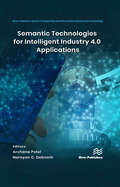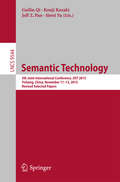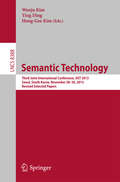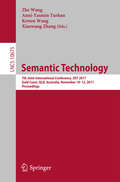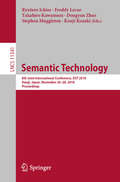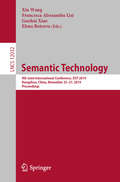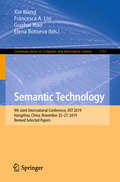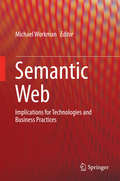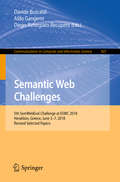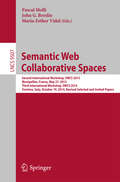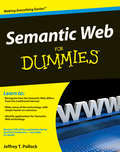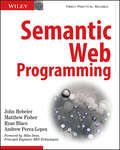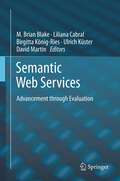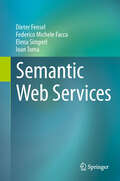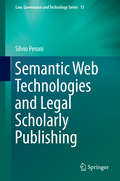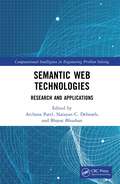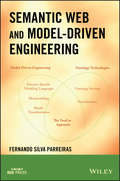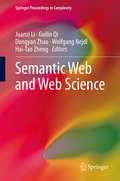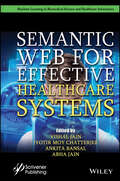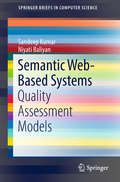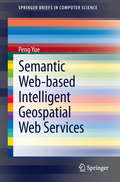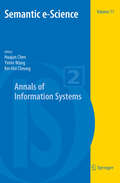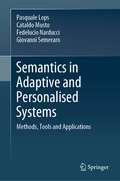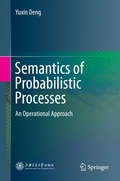- Table View
- List View
Semantic Technologies for Intelligent Industry 4.0 Applications (River Publishers Series in Computing and Information Science and Technology)
by Narayan C. Debnath Archana PatelAs the world enters the era of big data, there is a serious need to give a semantic perspective to the data in order to find unseen patterns, derive meaningful information, and make intelligent decisions. Semantic technologies offer the richest machine-interpretable (rather than just machine-processable) and explicit semantics that are being extensively used in various domains and industries. These technologies reduce the problem of large semantic loss in the process of modelling knowledge, and provide sharable, reusable knowledge,and a common understanding of the knowledge. As a result, the interoperability and interconnectivity of the model make it priceless for addressing the issues of querying data. These technologies work with the concepts and relations that are very lose to the working of the human brain. They provide a semantic representation of any data format: unstructured or semi-structured. As a consequence, data becomes real-world entity rather than a string of characters. For these reasons, semantic technologies are highly valuable tools to simplify the existing problems of the industry leading to new opportunities. However, there are some challenges that need to be addressed to make industrial applications and machines smarter. This book aims to provide a roadmap for semantic technologies and highlights the role of these technologies in industry. The book also explores the present and future prospects of these semantic technologies along with providing answers to various questions like: Are semantic technologies useful for the next era (industry 4.0)? Why are semantic technologies so popular and extensively used in the industry? Can semantic technologies make intelligent industrial applications? Which type of problem requires the immediate attention of researchers? Why are semantic technologies very helpful in people’s future lives? This book will potentially serve as an important guide towards the latest industrial applications of semantic technologies for the upcoming generation, and thus becomes a unique resource for scholars, researchers, professionals and practitioners in the field.
Semantic Technology
by Guilin Qi Kouji Kozaki Jeff Z. Pan Siwei YuThisbook constitutes the thoroughly refereed proceedings of the 5th JointInternational Semantic Technology Conference, JIST 2015, held in Yichang,China, in November 2015. The theme of the JIST 2015 conference was "Big Data andSocial Media". The JIST 2015 conference consisted of main technical tracksincluding 2 keynotes, 2 invited talks, a regular technical paper track (fulland short papers), an in-use track, a poster and demo session, workshop, andtutorial. The 14 full and 8 short papers in this volume were carefullyreviewed and selected from 43 submissions. The paper cover the followingtopics: ontology and reasoning, linked data, learning and discovery, RDF andquery, knowledge graph, knowledge integration, query and recommendation, andapplications of semantic technologies.
Semantic Technology
by Ying Ding Wooju Kim Hong-Gee KimThis book constitutes the proceedings of the Third Joint International Semantic Technology Conference, JIST 2013, held in Seoul, South Korea, in November 2013. The 32 papers, included four tutorials and 5 workshop papers, in this volume were carefully reviewed and selected from numerous submissions. The contributions are organized in topical sections on semantic Web services, multilingual issues, biomedical applications, ontology construction, semantic reasoning, semantic search and query, ontology mapping, and learning and discovery.
Semantic Technology: 7th Joint International Conference, JIST 2017, Gold Coast, QLD, Australia, November 10-12, 2017, Proceedings (Lecture Notes in Computer Science #10675)
by Zhe Wang Anni-Yasmin Turhan Kewen Wang Xiaowang ZhangThis book constitutes the thoroughly refereed proceedings of the 7th Joint International Semantic Technology Conference, JIST 2017, held in Goldcoast, QLD, Australia, in November 2017. The 19 full papers and 4 short papers presented were carefully reviewed and selected from 37 submissions. They present applications of semantic technologies, theoretical results, new algorithms and tools to facilitate the adoption of semantic technologies and are organized in topical sections on ontology and data management; ontology reasoning; linked data and query; information retrieval and knowledge discovery; knowledge graphs; and applications of semantic technologies.
Semantic Technology: 8th Joint International Conference, JIST 2018, Awaji, Japan, November 26–28, 2018, Proceedings (Lecture Notes in Computer Science #11341)
by Kouji Kozaki Dongyan Zhao Freddy Lecue Ryutaro Ichise Takahiro Kawamura Stephen MuggletonThis book constitutes the thoroughly refereed proceedings of the 8th Joint International Semantic Technology Conference, JIST 2018, held in Awaji, Japan, in November 2018. The 23 full papers and 6 short papers presented were carefully reviewed and selected from 75 submissions. They present applications of semantic technologies, theoretical results, new algorithms and tools to facilitate the adoption of semantic technologies and are organized in topical sections on knowledge graphs; data management; question answering and NLP; ontology and reasoning; government open data; and semantic web for life sciences.
Semantic Technology: 9th Joint International Conference, JIST 2019, Hangzhou, China, November 25–27, 2019, Proceedings (Lecture Notes in Computer Science #12032)
by Xin Wang Francesca Alessandra Lisi Guohui Xiao Elena BotoevaThis book constitutes the thoroughly refereed proceedings of the 9th Joint International Semantic Technology Conference, JIST 2019, held in Hangzhou, China, in November 2019. The 24 full papers presented were carefully reviewed and selected from 70 submissions. They present applications of semantic technologies, theoretical results, new algorithms and tools to facilitate the adoption of semantic technologies and are organized in topical sections on knowledge graphs; data management; question answering and NLP; ontology and reasoning; government open data; and semantic web for life sciences.
Semantic Technology: 9th Joint International Conference, JIST 2019, Hangzhou, China, November 25–27, 2019, Revised Selected Papers (Communications in Computer and Information Science #1157)
by Xin Wang Francesca A. Lisi Guohui Xiao Elena BotoevaThis book constitutes the thoroughly refereed proceedings of the 9th Joint International Semantic Technology Conference, JIST 2019, held in Hangzhou, China, in November 2019.The 12 full papers and 12 short papers presented were carefully reviewed and selected from 70 submissions. The papers present applications of semantic technologies, theoretical results, new algorithms and tools to facilitate the adoption of semantic technologies.
Semantic Technology: Third Joint International Conference, JIST 2013, Seoul, South Korea, November 28--30, 2013, Revised Selected Papers (Lecture Notes in Computer Science #8388)
by Wooju Kim, Ying Ding and Hong-Gee KimThis book constitutes the proceedings of the Third Joint International Semantic Technology Conference, JIST 2013, held in Seoul, South Korea, in November 2013.The 32 papers, included four tutorials and 5 workshop papers, in this volume were carefully reviewed and selected from numerous submissions. The contributions are organized in topical sections on semantic Web services, multilingual issues, biomedical applications, ontology construction, semantic reasoning, semantic search and query, ontology mapping, and learning and discovery.
Semantic Web
by Michael WorkmanThis book examines recent developments in semantic systems that can respond to situations and environments and events. The contributors to this book cover how to design, implement and utilize disruptive technologies. The editor discusses the two fundamental sets of disruptive technologies: the development of semantic technologies including description logics, ontologies and agent frameworks; and the development of semantic information rendering and graphical forms of displays of high-density time-sensitive data to improve situational awareness. Beyond practical illustrations of emerging technologies, the editor proposes to utilize an incremental development method called knowledge scaffolding -a proven educational psychology technique for learning a subject matter thoroughly. The goal of this book is to help readers learn about managing information resources, from the ground up and reinforcing the learning as they read on.
Semantic Web Challenges: 5th SemWebEval Challenge at ESWC 2018, Heraklion, Greece, June 3–7, 2018, Revised Selected Papers (Communications in Computer and Information Science #927)
by Diego Reforgiato Recupero Aldo Gangemi Davide BuscaldiThis book constitutes the thoroughly refereed post conference proceedings of the 4th edition of the Semantic Web Evaluation Challenge, SemWebEval 2018, co-located with the 15th European Semantic Web conference, held in Heraklion, Greece, in June 2018.This book includes the descriptions of all methods and tools that competed at SemWebEval 2018, together with a detailed description of the tasks, evaluation procedures and datasets. The 18 revised full papers presented in this volume were carefully reviewed and selected from 24 submissions. The contributions are grouped in the areas: the mighty storage challenge; open knowledge extraction challenge; question answering over linked data challenge; semantic sentiment analysis.
Semantic Web Collaborative Spaces
by Pascal Molli John G. Breslin Maria-Esther VidalThis book constitutes the thoroughly refereedpost-workshop proceedings of the Second International Workshop on Semantic WebCollaborative Spaces, SWCS 2013, held in Montpellier, France, in May 2013, andthe Third International Workshop on Semantic Web Collaborative Spaces, SWCS2014, held in Trentino, Italy, in October 2014. The 6 revised extended papers presented were carefullyreviewed and selected from 10 submissions. The papers are grouped in topicalsections on challenges in collaborative spaces, modeling collaborativecommunities and the role of semantics, semantic MediaWiki communities, andexploiting semantics in collaborative spaces.
Semantic Web For Dummies
by Jeffrey T. PollockSemantic Web technology is already changing how we interact with data on the Web. By connecting random information on the Internet in new ways, Web 3. 0, as it is sometimes called, represents an exciting online evolution. Whether you're a consumer doing research online, a business owner who wants to offer your customers the most useful Web site, or an IT manager eager to understand Semantic Web solutions, Semantic Web For Dummies is the place to start! It will help you: Know how the typical Internet user will recognize the effects of the Semantic Web Explore all the benefits the data Web offers to businesses and decide whether it's right for your business Make sense of the technology and identify applications for it See how the Semantic Web is about data while the "old" Internet was about documents Tour the architectures, strategies, and standards involved in Semantic Web technology Learn a bit about the languages that make it all work: Resource Description Framework (RDF) and Web Ontology Language (OWL) Discover the variety of information-based jobs that could become available in a data-driven economy You'll also find a quick primer on tech specifications, some key priorities for CIOs, and tools to help you sort the hype from the reality. There are case studies of early Semantic Web successes and a list of common myths you may encounter. Whether you're incorporating the Semantic Web in the workplace or using it at home, Semantic Web For Dummies will help you define, develop, implement, and use Web 3. 0.
Semantic Web Programming
by Matthew Fisher John Hebeler Mike Dean Ryan Blace Andrew Perez-LopezThe next major advance in the Web?Web 3.0?will be built on semantic Web technologies, which will allow data to be shared and reused across application, enterprise, and community boundaries. Written by a team of highly experienced Web developers, this book explains examines how this powerful new technology can unify and fully leverage the ever-growing data, information, and services that are available on the Internet. Helpful examples demonstrate how to use the semantic Web to solve practical, real-world problems while you take a look at the set of design principles, collaborative working groups, and technologies that form the semantic Web. The companion Web site features full code, as well as a reference section, a FAQ section, a discussion forum, and a semantic blog.
Semantic Web Services
by David Martin Brian Blake Birgitta König-Ries Liliana Cabral Ulrich KüsterOver the last decade, a great amount of effort and resources have been invested in the development of Semantic Web Service (SWS) frameworks. Numerous description languages, frameworks, tools, and matchmaking and composition algorithms have been proposed. Nevertheless, when faced with a real-world problem, it is still very hard to decide which of these different approaches to use. In this book, the editors present an overall overview and comparison of the main current evaluation initiatives for SWS. The presentation is divided into four parts, each referring to one of the evaluation initiatives. Part I covers the long-established first two tracks of the Semantic Service Selection (S3) Contest - the OWL-S matchmaker evaluation and the SAWSDL matchmaker evaluation. Part II introduces the new S3 Jena Geography Dataset (JGD) cross evaluation contest. Part III presents the Semantic Web Service Challenge. Lastly, Part IV reports on the semantic aspects of the Web Service Challenge. The introduction to each part provides an overview of the evaluation initiative and overall results for its latest evaluation workshops. The following chapters in each part, written by the participants, detail their approaches, solutions and lessons learned. This book is aimed at two different types of readers. Researchers on SWS technology receive an overview of existing approaches in SWS with a particular focus on evaluation approaches; potential users of SWS technologies receive a comprehensive summary of the respective strengths and weaknesses of current systems and thus guidance on factors that play a role in evaluation.
Semantic Web Services
by Dieter Fensel Elena Simperl Federico Michele Facca Ioan TomaA paradigm shift is taking place in computer science: one generation ago, we learned to abstract from hardware to software, now we are abstracting from software to serviceware implemented through service-oriented computing. Yet ensuring interoperability in open, heterogeneous, and dynamically changing environments, such as the Internet, remains a major challenge for actual machine-to-machine integration. Usually significant problems in aligning data, processes, and protocols appear as soon as a specific piece of functionality is used within a different application context. The Semantic Web Services (SWS) approach is about describing services with metadata on the basis of domain ontologies as a means to enable their automatic location, execution, combination, and use. Fensel and his coauthors provide a comprehensive overview of SWS in line with actual industrial practice. They introduce the main sociotechnological components that ground the SWS vision (like Web Science, Service Science, and service-oriented architectures) and several approaches that realize it, e.g. the Web Service Modeling Framework, OWL-S, and RESTful services. The real-world relevance is emphasized through a series of case studies from large-scale R&D projects and a business-oriented proposition from the SWS technology provider Seekda. Each chapter of the book is structured according to a predefined template, covering both theoretical and practical aspects, and including walk-through examples and hands-on exercises. Additional learning material is available on the book website www.swsbook.org. With its additional features, the book is ideally suited as the basis for courses or self-study in this field, and it may also serve as a reference for researchers looking for a state-of-the-art overview of formalisms, methods, tools, and applications related to SWS.
Semantic Web Technologies and Legal Scholarly Publishing
by Silvio PeroniThis work deals with the applications of Semantic Publishing technologies in the legal domain, i. e. , the use of Semantic Web technologies to address issues related to the Legal Scholarly Publishing. Research in the field of Law has a long tradition in the application of semantic technologies, such as Semantic Web and Linked Data, to real-world scenarios. This book investigates and proposes solutions for three main issues that Semantic Publishing needs to address within the context of the Legal Scholarly Publishing: the need of tools for linking document text to a formal representation of its meaning; the lack of complete metadata schemas for describing documents according to the publishing vocabulary and the absence of effective tools and user interfaces for easily acting on semantic publishing models and theories. In particular, this work introduces EARMARK, a markup meta language that allows one to create markup documents without the structural and semantic limits imposed by markup languages such as XML. EARMARK is a platform to link the content layer of a document with its intended formal semantics and it can be used with the Semantic Publishing and Referencing (SPAR) Ontologies, another topic in this book. SPAR Ontologies are a collection of formal models providing an upper semantic layer for describing the publishing domain. Using EARMARK as a foundation for SPAR descriptions opens up to a semantic characterisation of all the aspects of a document and of its parts. Finally, four user-friendly tools are introduced: LODE, KC-Viz, Graffoo and Gaffe. They were expressly developed to facilitate the interaction of publishers and domain experts with Semantic Publishing technologies by shielding such users from the underlying formalisms and semantic models of such technologies.
Semantic Web Technologies: Research and Applications (Computational Intelligence in Engineering Problem Solving)
by Bharat Bhushan Narayan C. Debnath Archana PatelSemantic web technologies (SWTs) offer the richest machine-interpretable (rather than just machine-processable) and explicit semantics that are being extensively used in various domains and industries. This book provides a roadmap for semantic web technologies (SWTs) and highlights their role in a wide range of domains including cloud computing, Internet of Things, big data, sensor network, and so forth. It also explores the prospects of these technologies including different data interchange formats, query languages, ontologies, Linked Data, and notations. The role of SWTs in ‘epidemic Covid-19’, ‘e-learning platforms and systems’, ‘block chain’, ‘open online courses’, and ‘visual analytics in healthcare’ is described as well. This book: Explores all the critical aspects of semantic web technologies (SWTs) Discusses the impact of SWTs on cloud computing, Internet of Things, big data, and sensor network Offers a comprehensive examination of the emerging research in the areas of SWTs and their related domains Provides a template to develop a wide range of smart and intelligent applications Includes latest applications and examples with real data This book is aimed at researchers and graduate students in computer science, informatics, web technology, cloud computing, and Internet of Things.
Semantic Web and Model-Driven Engineering
by Fernando S. ParreirasThe next enterprise computing era will rely on the synergy between both technologies: semantic web and model-driven software development (MDSD). The semantic web organizes system knowledge in conceptual domains according to its meaning. It addresses various enterprise computing needs by identifying, abstracting and rationalizing commonalities, and checking for inconsistencies across system specifications. On the other side, model-driven software development is closing the gap among business requirements, designs and executables by using domain-specific languages with custom-built syntax and semantics. It focuses on using modeling languages as programming languages.Among many areas of application, we highlight the area of configuration management. Consider the example of a telecommunication company, where managing the multiple configurations of network devices (routers, hubs, modems, etc.) is crucial. Enterprise systems identify and document the functional and physical characteristics of network devices, and control changes to those characteristics. Applying the integration of semantic web and model-driven software development allows for(1) explicitly specifying configurations of network devices with tailor-made languages,(2) for checking the consistency of these specifications(3) for defining a vocabulary to share device specifications across enterprise systems. By managing configurations with consistent and explicit concepts, we reduce cost and risk, and enhance agility in response to new requirements in the telecommunication area.This book examines the synergy between semantic web and model-driven software development. It brings together advances from disciplines like ontologies, description logics, domain-specific modeling, model transformation and ontology engineering to take enterprise computing to the next level.
Semantic Web and Web Science
by Guilin Qi Wolfgang Nejdl Dongyan Zhao Hai-Tao Zheng Juanzi LiThe book will focus on exploiting state of the art research in semantic web and web science. The rapidly evolving world-wide-web has led to revolutionary changes in the whole of society. The research and development of the semantic web covers a number of global standards of the web and cutting edge technologies, such as: linked data, social semantic web, semantic web search, smart data integration, semantic web mining and web scale computing. These proceedings are from the 6th Chinese Semantics Web Symposium.
Semantic Web for Effective Healthcare Systems
by Jyotir Moy Chatterjee Vishal Jain Ankita Bansal Abha JainRecently, the Semantic Web has gained huge popularity to address these challenges. Semantic web technologies have the opportunity to transform the way healthcare providers utilize technology to gain insights and knowledge from their data and make decisions. Both big data and semantic web technologies can complement each other to address the challenges and add intelligence to healthcare management systems. The aim of this book is to analyze the current status on how Semantic Web is used to solve the health data integration and interoperability problem, how it provides advanced data linking capabilities that can improve search and retrieval of medical data. There are chapters in the book which analyze the tools and approaches to semantic health data analysis and knowledge discovery. The book discusses the role of semantic technologies in extracting and transforming healthcare data before storing it in repositories. It also discusses different approaches for integrating heterogeneous healthcare data. To summarize, the book will help readers understand key concepts in semantic web applications for biomedical engineering and healthcare.
Semantic Web-Based Systems: Quality Assessment Models (SpringerBriefs in Computer Science)
by Sandeep Kumar Niyati BaliyanThe book initially presents the basic concepts related to the Semantic Web, Semantic Web-based applications, Web applications, Ontology, and their qualitative aspects. It then presents the evaluation of the structural quality of modular ontologies and review on metrics for the evaluation of ontology behavior.Further, the book discusses the qualitative evaluation of Semantic Web applications deployed on the Cloud, helping readers understand, maintain, integrate, and reuse these applications. The book offers software engineers in general and ontology engineers in particular a single, valuable guide to help them find the best modularization on the basis of goodness of (re) use. It can also serve as an initial source of information for starting research in this domain.
Semantic Web-based Intelligent Geospatial Web Services
by Peng YueBy introducing Semantic Web technologies into geospatial Web services, this book addresses the semantic description of geospatial data and standards-based Web services, discovery of geospatial data and services, and generation of composite services. Semantic descriptions for geospatial data, services, and geoprocessing service chains are structured, organized, and registered in geospatial catalogue services. The ontology-based approach helps to improve the recall and precision of data and services discovery. Semantics-enabled metadata tracking and satisfaction allows analysts to focus on the generation of a geospatial process model rather than spending large amounts of time in data preparation. "DataType"-driven service composition and path planning can help to automate a range of knowledge discovery processes in a limited geospatial domain. Process planning facilitates the construction of complex services and models for geocomputation. A three-phase procedure to cover the lifecycle of service chaining and to identify the roles of the methods involved is proposed. It includes process modeling, process model instantiation, and workflow execution. The approach is implemented in a prototype system with use cases to demonstrate applicability. The objective of the research is to develop the key technologies for an intelligent geospatial knowledge system based on Web services to automate the data discovery and data preprocessing steps in the distributed Web service environment, to automate a range of knowledge discovery processes in a limited geospatial domain, using the automated construction and execution of service chains, and to facilitate the construction of complex services and models for geocomputation.
Semantic e-Science
by Huajun Chen Kei-Hoi Cheung Yimin WangThe Semantic Web has been a very important development in how knowledge is disseminated and manipulated on the Web, but it has been of particular importance to the flow of scientific knowledge, and will continue to shape how data is stored and accessed in a broad range of disciplines, including life sciences, earth science, materials science, and the social sciences. After first presenting papers on the foundations of semantic e-science, including papers on scientific knowledge acquisition, data integration, and workflow, this volume looks at the state of the art in each of the above-mentioned disciplines, presenting research on semantic web applications in the life, earth, materials, and social sciences. Drawing papers from three semantic web workshops, as well as papers from several invited contributors, this volume illustrates how far semantic web applications have come in helping to manage scientific information flow.
Semantics in Adaptive and Personalised Systems: Methods, Tools and Applications
by Giovanni Semeraro Pasquale Lops Cataldo Musto Fedelucio NarducciThis monograph gives a complete overview of the techniques and the methods for semantics-aware content representation and shows how to apply such techniques in various use cases, such as recommender systems, user profiling and social media analysis. Throughout the book, the authors provide an extensive analysis of the techniques currently proposed in the literature and cover all the available tools and libraries to implement and exploit such methodologies in real-world scenarios. The book first introduces the problem of information overload and the reasons why content-based information needs to be taken into account. Next, the basics of Natural Language Processing are provided, by describing operations such as tokenization, stopword removal, lemmatization, stemming, part-of-speech tagging, along with the main problems and issues. Finally, the book describes the different approaches for semantics-aware content representation: such approaches are split into ‘exogenous’ and ‘endogenous’ ones, depending on whether external knowledge sources as DBpedia or geometrical models and distributional semantics are used, respectively. To conclude, several successful use cases and an extensive list of available tools and resources to implement the approaches are shown. Semantics in Adaptive and Personalised Systems definitely fills the gap between the extensive literature on content-based recommender systems, natural language processing, and the different types of semantics-aware representations.
Semantics of Probabilistic Processes
by Yuxin DengThis book discusses the semantic foundations of concurrent systems with nondeterministic and probabilistic behaviour. Particular attention is given to clarifying the relationship between testing and simulation semantics and characterising bisimulations from metric, logical, and algorithmic perspectives. Besides presenting recent research outcomes in probabilistic concurrency theory, the book exemplifies the use of many mathematical techniques to solve problems in computer science, which is intended to be accessible to postgraduate students in Computer Science and Mathematics. It can also be used by researchers and practitioners either for advanced study or for technical reference.
